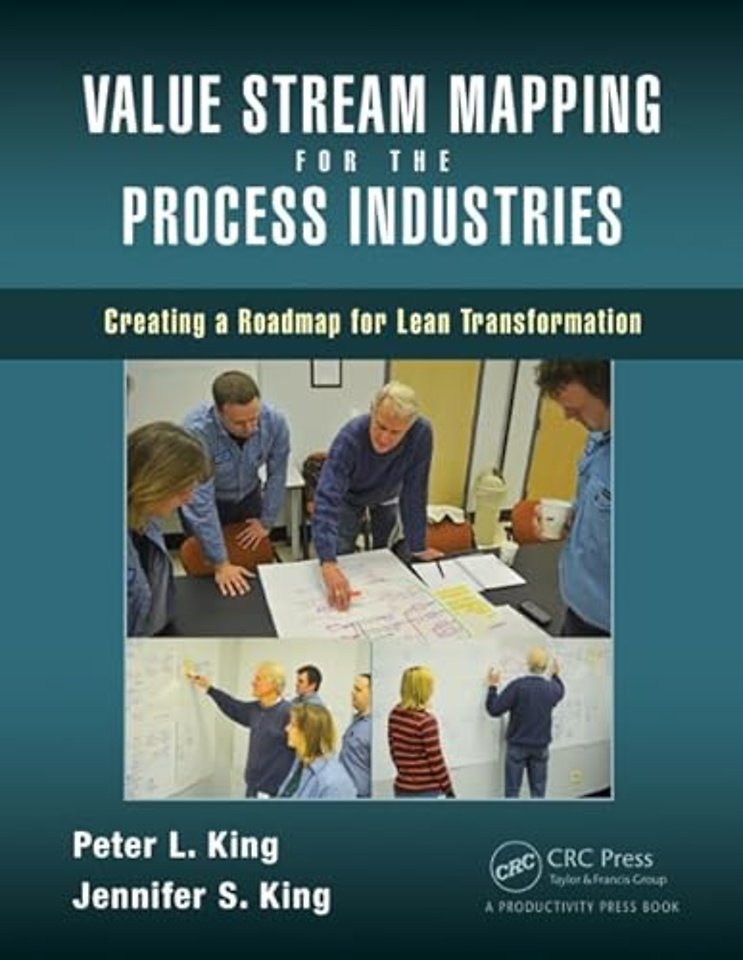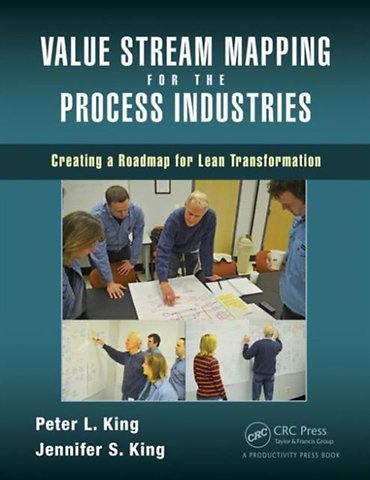Value Stream Mapping for the Process Industries
Creating a Roadmap for Lean Transformation
Paperback Engels 2015 1e druk 9781482247688Samenvatting
Providing a framework that highlights waste and its negative effects on process performance, value stream maps (VSMs) are essential components for successful Lean initiatives. While the conventional VSM format has the basic structure to effectively describe process operations, it must be adapted and expanded to serve its purpose in the process industry.
This book describes in detail how to create a complete VSM for a process industry manufacturing operation. Detailing the unique features of process operations and why they require additions and adjustments to traditional VSMs, the book walks readers through the steps in analyzing the map. It explains how to scope improvement projects, prioritize them, and then use future state VSMs to illustrate and motivate systemic improvement. In doing so, it supplies readers with a roadmap for a complete Lean transformation.
- Describes how to analyze the map for waste and flow issues so that they can be reduced and even eliminated
- Provides examples of the calculations needed for the flow parameters in data boxes
- Explains how the VSM concept can be applied to the entire supply chain
- Includes strategies for engaging your entire workforce in map creation
The book introduces a target manufacturing process and uses it to describe how to create a complete VSM. The target process is complex enough to illustrate the issues often encountered in mapping a process industry operation, but straightforward enough to explain all of the mapping considerations and decisions.
The book includes real examples of how VSMs brought much greater clarity to the real issues the processes faced and cases where the insight enabled management to avoid costly, inappropriate investments.
Specificaties
Lezersrecensies
Inhoudsopgave
A Focus on Flow Rather Than on Function
Summary
Value Stream Mapping Fundamentals
Introduction to Value Stream Mapping
Material Flow
Major Process Steps
Data Boxes
Process Box and Process Data Box
Inventory Data Box
Transportation Data Box
Customers Data Box
Supplier Data Box
Material and Information Flow Icons
Information Flow
The Third VSM Component—The Timeline
Parallel Equipment
Level of Detail
Summary
VSM Enhancements for Process Operations
Distinguishing Features of Process Operations That Require a Different VSM Approach
Capital Intensive vs. Labor Intensive
Material Flow Patterns—SKU Fan Out
Product Changeover Issues Are Complex
Product Families—Selecting a Target Product or Family
Takt Rate vs. Takt Time
Units of Production
Generating the Map
Time Units
Where to Begin
Summary
Additional Good Mapping Practices
Good VSM Practices
Map Layout—Flow Direction
Level of Detail
Level of Precision
Parallel Equipment
Logical Flow vs. Geographic Arrangement
Support Processes
Computer Tools vs. Brown Paper
Qualified Guidance and Coaching
Summary
Our Focusing Problem—A Synthetic Fiber Process
Process Overview
Raw Materials
Step 1: Polymerization
Step 2: Fiber Spinning
Step 3: Draw–Anneal
Step 4: Cut—Bale
Finished Product Storage and Shipping
Order Processing and Production Scheduling
The Synthetic Fiber Manufacturing VSM
Developing the Material Flow
Calculating Data Box Parameters
Process Step Data Boxes
Overall Equipment Effectiveness (OEE)
Calculating Availability
Calculating Performance
Calculating Quality
Calculating OEE
Remaining Factors
Another Example of OEE
Supplier Data Boxes
Customer Data Boxes
Inventory Data Boxes
Transportation Data Boxes
Summary
Material Flow Rates and Takt
Calculating Takt
Bales
Rope Takt in Gaylords
Annealed Product Takt
Filament Takt
Flake, Spinning, and Polymer Takt
Raw Material Takt
Summary
Completing the Data Boxes: Utilization, Delivery Frequency, and Days of Supply
Utilization
Transportation Frequency
Inventory Days of Supply
Summary
Mapping the Information Flow
Why Map Information Flow?
Fiber Manufacturing Information Flow
Capacity Constraint Resources
Additional Information Mapping Tools
Summary
Developing the Timeline
Timeline Principles
Fiber VSM Timeline
Cash Flow Cycle Time
Summary
Finding the Waste—Analyzing the Map
General Impressions from the Current State
Inventory Opportunities
Baler Reliability
Spinning Yield
Long Campaign Cycles (EPEIs)
Hot Roll Draw–Anneal
Uncoordinated Scheduling
Capturing Potential Opportunities
Scoping the Opportunities
Inventory Opportunities
1. Raw Material Inventory in Rail Cars Is Too High
2. Flake Inventory Is High
3. Filament Inventory Is High
4. Rope Finished Product Inventory in Gaylords Is Too High
5. Right Size the Cutter Box Inventory
6. Bale Finished Product Inventory Is Too High
Equipment Opportunities
7. Spinning Changeover Losses Are High; Spinning Utilization Is High
8. Baler Reliability Is Poor
9. Changeover Improvement—Balers
10. Reduce the Baler Campaign Cycle (EPEI)
11. Mothball One Baler
12. Hot Roll Draw–Anneal Reliability and Yield Wastes
13. Mothball One Polymer Reactor
System-Wide Opportunities
14. Implement Virtual Cellular Flow
15. Filament Tub FIFOs after Implementation of Virtual Cells
16. Implement Pull Replenishment across the Value Stream
17. Drop the 60 Very Low Demand SKUs
Summary
Implementation Strategy and Sequence
Strategy for Implementation of Improvements
Riverside Fiber Plant Future States
Future State Generation 1
Future State Generation 2
Future State Generation 3
Summary
Future State Value Stream Maps
Why a Future State VSM?
Future State 1 Map
Future State 2 Map
Future State 3 Map
Summary
Supply Chain Mapping
Why a Supply Chain Map Is Important
Supply Chain Wastes
Effects of Wastes at the Supply Chain Level
Supply Chain Map Components
Future State Supply Chain Map
Supply Chain Map Example
Summary
VSM as a Way of Engaging Employees
Origin of the Problem
A New Paradigm on the Role of Labor
The Nature of Engagement
Summary
A Roadmap for Continuous Improvement
Summary
Benefits of Developing a VSM
Operations That Have Benefitted from Using a VSM
Processing of Large Rolls in a Sheet Goods Plant
Bottling Salad Dressing
Cooling Towers in Polyethylene Production
Producing Waxes for Coating Cardboard Boxes
Improving a Capital Project Execution System
Summary
Appendix A: Process Industry Characteristics
Characteristics That Distinguish the Process Industries
Equipment Is Large and Difficult to Relocate
Processes Are Difficult to Stop and Restart
Capital Intensive vs. Labor Intensive
Hidden WIP
Product Differentiation Points
Summary
Appendix B: SMED Principles
SMED Origins
SMED Concepts
Product Changeovers in the Process Industries
Summary
Appendix C: Cellular Flow
Typical Process Plant Equipment Configurations
Cellular Manufacturing Applied to Process Lines
Summary
Appendix D: Pull Replenishment Systems
Why Is Pull Important?
What Is Pull?
Pull in Assembly
Difficulties in Process Plants
Push–Pull Interface
ConWIP
Visual Signals
When to Start Pulling: The Sequence of Implementation
Value Stream Focus
Showing Pull on a Value Stream Map
Summary
Appendix E: Cycle Stock and Safety Stock
Cycle Stock and Safety Stock
Calculating Cycle Stock
Fixed Interval Replenishment Model
Fixed Quantity Replenishment Model
Safety Stock
Variability in Demand
Variability in Lead Time
Combined Variability
Example—Cut–Bale 2 Safety Stock
Summary
Appendix F: Product Wheels
Introduction to Product Wheels
Product Wheels Defined
Benefits of Product Wheels
Product Wheel Applicability
Process Improvement Time
Summary
Anderen die dit boek kochten, kochten ook
Rubrieken
- advisering
- algemeen management
- coaching en trainen
- communicatie en media
- economie
- financieel management
- inkoop en logistiek
- internet en social media
- it-management / ict
- juridisch
- leiderschap
- marketing
- mens en maatschappij
- non-profit
- ondernemen
- organisatiekunde
- personal finance
- personeelsmanagement
- persoonlijke effectiviteit
- projectmanagement
- psychologie
- reclame en verkoop
- strategisch management
- verandermanagement
- werk en loopbaan







